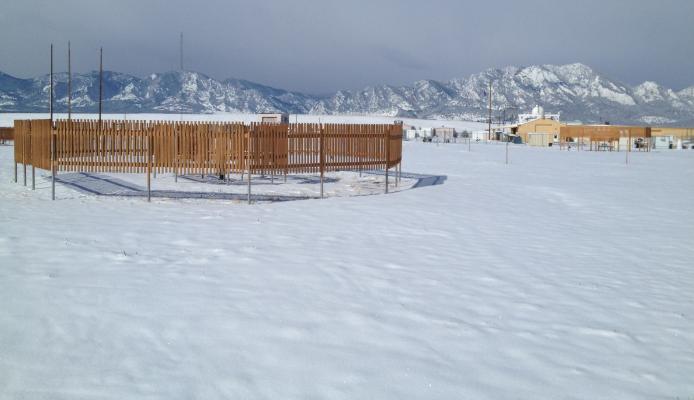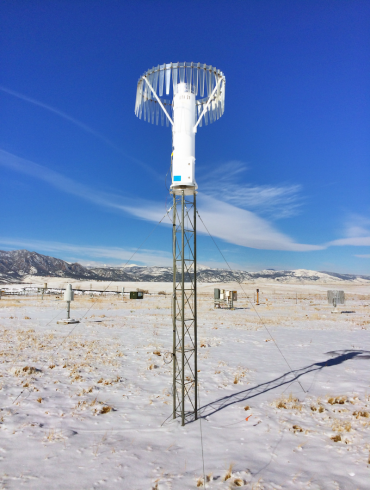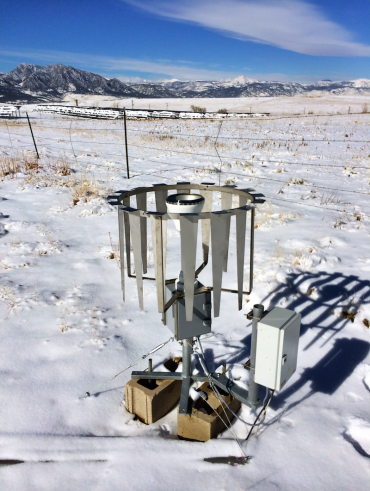
Weather Observations and Improvement
Extreme Conditions Make the Perfect Testbed

Weather Observations and Improvement
Extreme Conditions Make the Perfect Testbed
Instrumentation Testing & Data Gathering at the Marshall Field Site
The Marshall Field Site Instrument Testbed is an outdoor experimental lab located at the base of the foothills. Each season brings wide-ranging weather conditions such as strong downslope windstorms, freezing precipitation, upslope snowstorms, and thunderstorms. Because of these conditions, it is an ideal location for developing and testing weather instrumentation, and studying weather in all its forms.
An Outdoor Winter Weather Lab: Supporting Aviation Safety
After a number of high-profile aircraft accidents were linked to snow and ice buildup on aircraft in the 1990s, the FAA tasked NCAR scientists to develop techniques to improve aircraft icing practices to prevent future accidents. A test bed was established at the Marshall site to collect and accurately measure snowfall. Snowfall is particularly difficult to measure because wind blows it horizontally, issuing a challenge to accurately collect snow inside precipitation gauges.
NCAR developed a suite of measurement techniques using a variety of precipitation gauges and wind shields to diminish the horizontal momentum of the snowflakes. Scientists discovered that information on the liquid water equivalent (LWE) snowfall rate was critical for determining the effective time span deicing and anti-icing fluids would provide after being applied to an aircraft under specified precipitation rates and ambient air temperature. As more data were collected from the Marshall site, RAL scientists developed a state-of-the-art, integrated display system that depicts accurate, real-time nowcasts of the snowfall LWE rate. This display interface was tested at several airports around the country. After completing extensive testing and earning favorable reviews, the system was adopted by the FAA as an alternative method for airports to use in determining how long deicing and anti-icing fluids would remain effective during snowfall conditions.
Improved Precipitation Measurements Globally
“As weather, climate and the water cycle know no national boundaries, international cooperation at a global scale is essential for the development of meteorology, climatology and operational hydrology as well as to reap the benefits from their application.” This is the mandate of the World Meteorological Organization (WMO), the United Nations agency tasked with policymaking when weather and climate, operational hydrology and related geosciences are concerned.
NCAR’s Marshall Field Site was selected as the sole U.S. location for an international program studying the performance of modern automated sensors measuring solid precipitation. Marshall continues to host the testing of new gauges and other solid precipitation measurement techniques as part of the WMO Solid Precipitation Inter-Comparison Experiment (SPICE) program. Marshall was the only U.S. site selected, hosting more sensors than any other international participant. The WMO also tasked NCAR to manage the data gathered from 14 data collection sites scattered all over the globe. This is a testament to NCAR’s expert data processing capabilities, and its data management and data assimilation techniques.
Catching Snow in the World’s Southernmost Desert
The NSF sponsored a three-year field program in Antarctica to test recent advances in precipitation measurement technology to determine whether accurate snowfall measurements are now possible in polar conditions where temperatures can drop below minus 50 degrees Fahrenheit and wind speeds can exceed hurricane force. NCAR scientists, in collaboration with scientists at the University of Colorado, Boulder, designed an automated system, complete with precipitation gauges and wind shielding, to measure the small amount of snow that falls in the Antarctic regions. After testing at Marshall, these systems were installed in various Antarctic locations near McMurdo Station and then collected data year-round. This ongoing field project will supply researchers with critical information about how much snow is added to the polar ice caps, and help climatologists build a better understanding of sea-level rise associated with climate change.
Contributing to the Nation’s Long-term Climate Record
To expand the nation’s Climate Reference Network, NCAR’s Marshall Site was selected by NOAA in 2008 to support their objective of accurately measuring precipitation with state-of-the-art precipitation gauges and shields, temperature, and wind-speed instruments. The data gathered will be used to provide high-quality, long-term observations to foster the nation’s goal of providing future long-term homogeneous temperature and precipitation observations that can be coupled to long-term historical observations for the detection and attribution of present and future climate change. NOAA and NCAR continue to jointly develop and test new forms of gauge shielding to improve precipitation gauge collection processes while simplifying the installation of the gauge wind shielding and minimizing costs related to wind-shield components.
Contact
Scott Landolt
Project Scientist II

